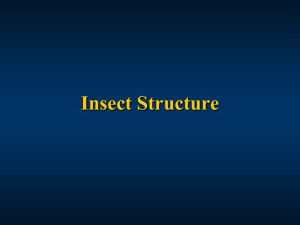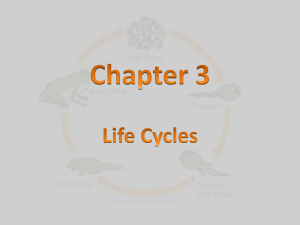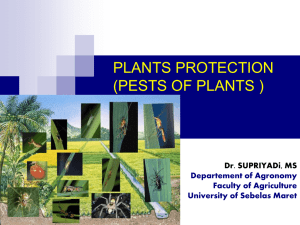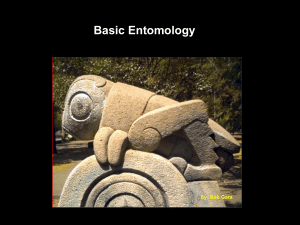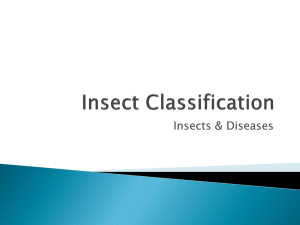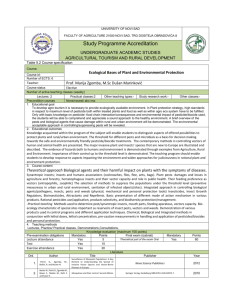Insects 101: Classifying to Order
advertisement
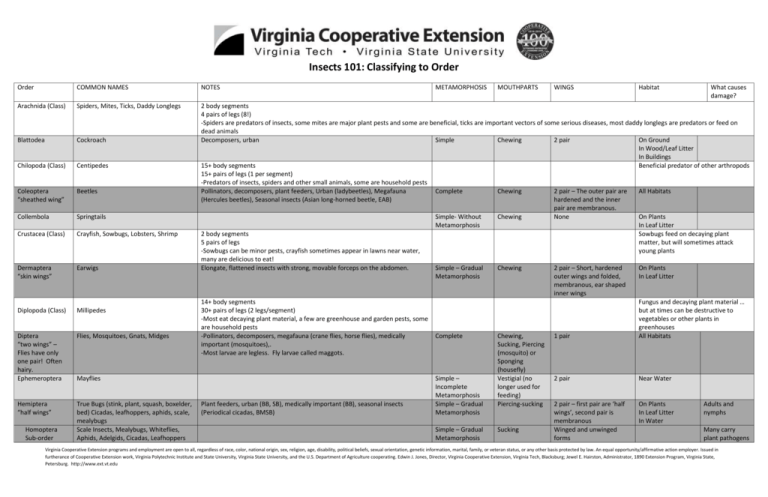
Insects 101: Classifying to Order Order COMMON NAMES NOTES Arachnida (Class) Spiders, Mites, Ticks, Daddy Longlegs Blattodea Cockroach Chilopoda (Class) Centipedes Coleoptera “sheathed wing” Beetles Collembola Springtails Crustacea (Class) Crayfish, Sowbugs, Lobsters, Shrimp Dermaptera “skin wings” Earwigs Diplopoda (Class) Millipedes Diptera “two wings” – Flies have only one pair! Often hairy. Ephemeroptera Flies, Mosquitoes, Gnats, Midges Hemiptera “half wings” True Bugs (stink, plant, squash, boxelder, bed) Cicadas, leafhoppers, aphids, scale, mealybugs Scale Insects, Mealybugs, Whiteflies, Aphids, Adelgids, Cicadas, Leafhoppers 2 body segments 4 pairs of legs (8!) -Spiders are predators of insects, some mites are major plant pests and some are beneficial, ticks are important vectors of some serious diseases, most daddy longlegs are predators or feed on dead animals Decomposers, urban Simple Chewing 2 pair On Ground In Wood/Leaf Litter In Buildings 15+ body segments Beneficial predator of other arthropods 15+ pairs of legs (1 per segment) -Predators of insects, spiders and other small animals, some are household pests Pollinators, decomposers, plant feeders, Urban (ladybeetles), Megafauna Complete Chewing 2 pair – The outer pair are All Habitats (Hercules beetles), Seasonal insects (Asian long-horned beetle, EAB) hardened and the inner pair are membranous. Simple- Without Chewing None On Plants Metamorphosis In Leaf Litter 2 body segments Sowbugs feed on decaying plant 5 pairs of legs matter, but will sometimes attack -Sowbugs can be minor pests, crayfish sometimes appear in lawns near water, young plants many are delicious to eat! Elongate, flattened insects with strong, movable forceps on the abdomen. Simple – Gradual Chewing 2 pair – Short, hardened On Plants Metamorphosis outer wings and folded, In Leaf Litter membranous, ear shaped inner wings 14+ body segments Fungus and decaying plant material … 30+ pairs of legs (2 legs/segment) but at times can be destructive to -Most eat decaying plant material, a few are greenhouse and garden pests, some vegetables or other plants in are household pests greenhouses -Pollinators, decomposers, megafauna (crane flies, horse flies), medically Complete Chewing, 1 pair All Habitats important (mosquitoes),. Sucking, Piercing -Most larvae are legless. Fly larvae called maggots. (mosquito) or Sponging (housefly) Simple – Vestigial (no 2 pair Near Water Incomplete longer used for Metamorphosis feeding) Plant feeders, urban (BB, SB), medically important (BB), seasonal insects Simple – Gradual Piercing-sucking 2 pair – first pair are ‘half On Plants Adults and (Periodical cicadas, BMSB) Metamorphosis wings’, second pair is In Leaf Litter nymphs membranous In Water Simple – Gradual Sucking Winged and unwinged Many carry Metamorphosis forms plant pathogens Homoptera Sub-order Mayflies METAMORPHOSIS MOUTHPARTS WINGS Habitat What causes damage? Virginia Cooperative Extension programs and employment are open to all, regardless of race, color, national origin, sex, religion, age, disability, political beliefs, sexual orientation, genetic information, marital, family, or veteran status, or any other basis protected by law. An equal opportunity/affirmative action employer. Issued in furtherance of Cooperative Extension work, Virginia Polytechnic Institute and State University, Virginia State University, and the U.S. Department of Agriculture cooperating. Edwin J. Jones, Director, Virginia Cooperative Extension, Virginia Tech, Blacksburg; Jewel E. Hairston, Administrator, 1890 Extension Program, Virginia State, Petersburg. http://www.ext.vt.edu Hymenoptera Isoptera ‘equal wings’ – wings are of equal size and shape Lepidoptera Mantodea Mecoptera Neuroptera Odonata Wasps, bees, ants, sawflies, horntails, velvet ants, honey bees, European hornets, fire ants, Asian needle ants Termites Pollinators (W,B,A) decomposers (A), Plant feeders (S,H,B), Megafauna (W,B,V), medically important (W,B,A), seasonal insects (HB, EH, FA, ANA) Urban Complete Chewing-lapping 2 pair On Ground On Plants Simple- Gradual Metamorphosis Chewing 2 pair Near Soil and Wood In Buildings Butterflies, moths, caterpillars, cutworms Pollinators, plant feeders, season insects (gypsy moths, squash stem borer) Complete -Larvae are voracious eaters Chewing (larvae) or siphoning (adult) 2 pair – Membranous wings covered with small scales On Plants Mantids Scorpionflies Lacewings, Antlions, Snakeflies, Mantispids, Dustywing, Alderfly, Dobsonflies Dragonflies, Damselflies Megafauna Megafauna Megafauna Simple Complete Complete -Many are aquatic as larvae Simple – Incomplete Simple – Gradual Metamorphosis Chewing 2 pair On Plants Chewing 2 pair Insect Predators Chewing 2 pair On Plants Near Water On Ground Near Water Chewing 2 pair – Forewings are elongated, narrow and hardened. Hind wings are membranous. On Plants On Ground In Buildings Adults and Nymphs Simple Simple Chewing Chewing or Sucking Chewing 2 pair None On Plants On Birds or Mammals Near Water Piercing-Sucking None On Birds or Mammals Rasping-sucking Chewing 2 pair – Slender, featherlike, with fringed hairs None Chewing 2 pair On Plants In Leaf Litter In Leaf Litter In Buildings Near Water Megafauna Orthoptera Crickets, Grasshoppers, Katydids, Praying Mantid Phamatodea Phasmida Phthiraptera Walking Sticks Walkingsticks Lice Plant Feeders, Megafauna Plecoptera Stoneflies Megafauna Siphonaptera Fleas Urban, Medically important Symphyla (Class) Symphalans 15-22 body segments 10-12 pairs of legs -Can be serious pests of vegetables, tree seedlings and greenhouse crops Thysanoptera Thrips Thysanura Silverfish Trichoptera Caddisflies Urban, medically important Simple – Incomplete Compete Simple – Gradual Metamorphosis Simple – Without Metamorphosis Complete 2 pair IMPORTANT TO GARDENER: ORDERS OF Insects CLASSES OF Non-Insects (‘Insect Look alikes’) ORDERS OF Other Insects Commonly seen Virginia Cooperative Extension programs and employment are open to all, regardless of race, color, national origin, sex, religion, age, disability, political beliefs, sexual orientation, genetic information, marital, family, or veteran status, or any other basis protected by law. An equal opportunity/affirmative action employer. Issued in furtherance of Cooperative Extension work, Virginia Polytechnic Institute and State University, Virginia State University, and the U.S. Department of Agriculture cooperating. Edwin J. Jones, Director, Virginia Cooperative Extension, Virginia Tech, Blacksburg; Jewel E. Hairston, Administrator, 1890 Extension Program, Virginia State, Petersburg. http://www.ext.vt.edu
